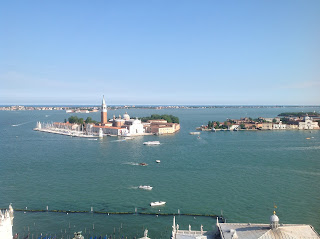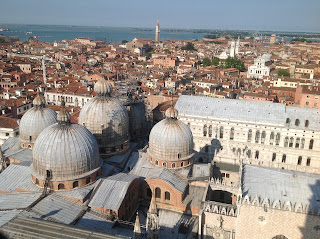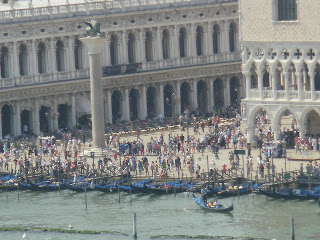 |
| St Mark's Square |
While relaxing we brought up Rick Steve's downloaded of the audio tour of St. Marks Square and the Basilica on our IPad. It gave us a clear purpose of what we planned to see when we got there.
We put on comfortable shoes and I wore a shirt that covered by shoulders and pants that covered my knees. Visiting Spain last year, I remembered that entering a church knees and shoulders must be covered or you could be turned away. There was a time ladies had to also wear something over their heads, but that is not necessary anymore in Catholic churches. Lots of changes have come about such as saying mass in the spoken language of the people and allow lay people to help give communion which speeds things up. It is not unusual to see casual dress is permitted with the exceptions of the abominable exposure of shoulders and knees!
 |
| Torre dell'Orologio |
We finally got to the entrance of St Mark's Basilica and we could see that parts of the building were covered for restoration. I also noticed that the Aussies got little wraps to put over their exposed joints!
 | |||||
| St. Mark's Basilica |
The floor plan of the church is like a Greek cross unlike most Catholic churches that are planned along the lines of a Christian cross. It opens to the atrium, nave, central dome, and main altar at the far end. Along the sides are the north and south transepts. It resembles a perfect circle if you connect the dots. The church was the center of state as well as center of religious celebrations. The Doge or Duke had a special door to enter from his adjoining palace and would take the pulpit when he needed to declare items of state.
As we stood in the front of the church we noticed the Last Judgement mosaic. Directly above the dome are the statues of the four horses. Above the next dome sits the golden winged lion and finally above the onion domes ornamental facade is the statue of St. Mark.
The four horses which are replicas of the real statues in the museum. These horses were part of the booty that was stolen from the Hippodrome in Constantinople by the Fourth Crusade in 1202. The Byzantine empire was the eastern part of the Roman empire. They were Christians and spoke Greek. Nevertheless, The Doge and the Crusaders stole the horses and other treasured items and brought them to Venice. Upon Napoleon's invasion of Venice, the horses were taken to Paris. When Napoleon was overthrown, the horses were returned to St. Marks. They were placed inside the museum after deterioration occurred due to air pollution.
 |
| Horses stolen from Constantinople by the Crusades. |
Mosaics told the stories of the bible to people who did not read, like comic books. Mosaics were the chosen media for Byzantine churches, and this was an example of the finest mosaics of the time. Many were designed by Renaissance artist but made in the byzantine style.
Beyond the Atrium we stepped into the Nave. There are over 5,000 mosaics in the church. Even the floor is in mosaic.
 |
| Floor mosaic |
 |
| Pentecost dome |
There was so much to see to dazzle the eye, and it would have been great if one could just lie down on the floor and look up without having to crane one's neck and walk at the same time. Up ahead was the spectacular Golden Altarpiece under which are the remains of St Mark. We would go there after checking out the Treasury where many of the other relics were kept that were taken from Constantinople in 1202.
We made our way to the Treasury and paid a fee to get in. John inquired about the audio guide and the clerk reset two and gave them to us. You had to ask for them or he would not give them out, as we observed other patrons walking around without the audio guide. It was most helpful in understanding what we saw. There were countless pieces of extraordinary objects that we enjoyed listening about. When we were through, we asked the clerk if we could "rewind" and go through again. The second time was even better, and we enjoyed our second go around even more than the first time!
This treasure was so well known in Europe that it was mentioned in the Man of La Mancha, by Miguel Cervantes published in 1605. It was compared to the wealth obtained from the Cierro Rico in Potosi, Bolivia in the late 1500 which raised the world's wealth by 53% The wealth from the new world went to Spain and caused the decline of Venetian influence in Europe.
 |
| Some of the beautiful golden goblets decorated with priceless gems. |
 | |
| Built in 12th century but rebuilt in 1912 after it fell in 1902. |
 |
| The other bell tower on the island. |
 |
| The custom house at the point and La Salute Church |
 |
| Bird's eye view of the city |
 |
| Top of the Basilica |
 |
| Top of the Doge Museum |
Back at St Mark's Square the restaurants were doing great business as we tried to find a WC (bathroom). We were given directions to go toward the Napoleon Wing and follow the walkway beyond. We finally located it and went upstairs. We were told that we had to pay a euro to go to the bathroom. We all got in line men and women in the same line to the same bathroom. We got ready to enter through the turn style. A German lady had deposited her coin and tried to pass through but the turn style would not turn. She looked at the attendant and tried to make a joke of it, but the attendant did not find it funny and refused to help her. We all waited because none of us could pass until this got resolved. Again she asked the lady for help, and she spat some Italian words at her and refused to help. So the German lady who was pretty hefty, did her best to climb over the turn style and went in. We all yelled in support, but gave our euros courteously to the attendant in hope none of us would have the same problem.
We turned left and followed the pathway over the first bridge. Looking between the two buildings there is another bridge connecting the Doge's Palace and the prison. This bridge is known as the Bridge of Sighs. It is said that Casanova once had been put in this prison doing a lot of sighing. He wrote a book I am eager to read when I finish The Infierno by Dan Brown.
We continued our walk and came upon the plush Daniele Hotel that was mentioned in my Italian class. According to our professor, John and Mabel Ringling and designed their Ca d'Zan with this very hotel in mind. So I took a picture of it and tried to take pictures of the Murano glass chandeliers
 |
| The Danieli Hotel |
 |
| Murano Chandelier and plush interior! |
As it seemed that we had to pass a few more bridges, and since we had to wait, I did more window shopping!
 |
| Murano Glass |
 |
| Aprons for cooking Italian meals. |
 | ||||||||||
| Shoes! |
Here are some ficton books that you may enjoy reading based in Venice:
Serenissima by Erica Jong
The Venitian Mask by Rosalind Laker
Bianca by Robert S. Elegant
Dressed for Death and 12 other books as Guido Brunetti mysteries by Donna Leon
Pippa Passes (a story of a dancer in modern Venice) by Rumer Godden
Dead Lagoon (an aurelo Zen mystery by Michael Dibdin
In the Company of the Courtesan by Sarah Dunnant










No comments:
Post a Comment